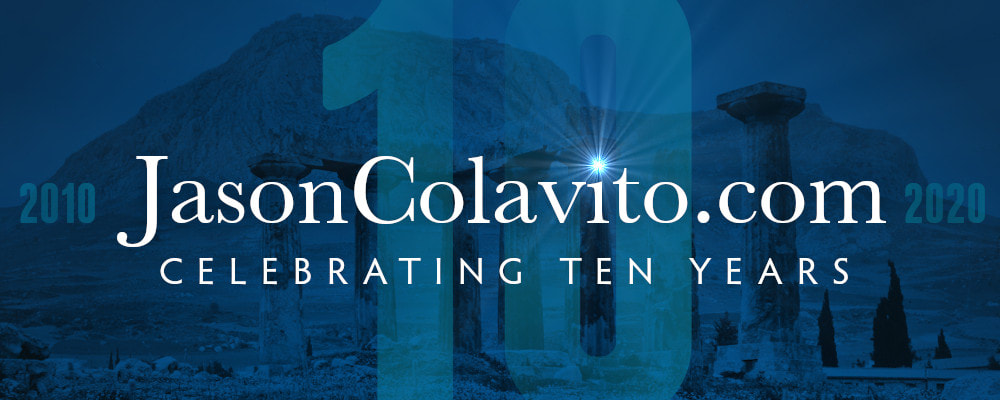26 Comments
This week, Vice and The Atlantic published two important articles outlining the growing religious fervor behind Q-Anon conspiracy theories. They make interesting comparison reading. In The Atlantic, Adrienne LaFrance traces the origins of the Q-Anon conspiracy theory and explains why faith in the unreason behind its patently false claims has the makings of an incipient religion. Leading figures in the Q movement openly declare that the conspiracy has divine sanction. One of the Q movement’s biggest names, David Hayes (a.k.a. PrayingMedic on Q forums), alleges that God has personally called him to Q-Anon. the Q-Anon conspiracy imagines an apocalyptic End Times when the blood of liberals will run in the streets and Donald Trump will usher in a new Great Awakening as the angels sing choruses of Kid Rock songs and clouds of sanctifying soot rain from a million coal-burning factories.
During the nineteenth century, a craze emerged for claiming the medieval Norse as the first Europeans to visit the Americas, long before Columbus. The core of the claim turned out to be true. Vikings reached eastern Canada around 1000 CE, though the Victorians had no real physical evidence of this, only a few medieval texts and some hoaxed stones. But advocates soon expanded the claim beyond the evidence and beyond logic, turning the Vikings into an early version of European imperialists, imagining them colonizing both North and South America and bequeathing European culture to the natives. The French writer Eugène Beauvois was perhaps the most extreme advocate, imagining the entire civilization of ancient Mexico the work of the Norse. In South America, the twentieth century Nazi sympathizer and Peronist collaborator Jacques de Mahieu pushed a narrative that Vikings were the first Aryan colonizers of South America, and their early efforts paved the way for the Knights Templar.
Pop culture is suffused with attempts to escape from reality. I’ve lost count of how many TV shows and movies play around with questions of parallel worlds, virtual simulations, supernatural false realities, and artificial intelligence—not to mention the so-called “nonfiction” cable shows hunting for parallel worlds, interdimensional portals, and star gates to heaven. Just as the Victorians kept searching in vain for proof of an afterlife to justify their moral rigidity, our current culture seems to want nothing more than proof that this world is a fiction to justify amoral indifference and egoism. Seriously, if one more TV show goes down the road of parallel universes or false realities, I think I will stop watching altogether.
For much of the past decade—has it really been that long?—I have explored the many vicissitudes of the medieval Islamic legend that the Giza Pyramids were the work of an antediluvian leader, either Surid or Hermes. I’ve traced the story from its origins in the Thousands of Abu Ma‘shar through its classic form in the Akhbar al-zaman and its copyists to its introduction into modern pyramid mythology thanks, in no small measure, to contemporary writers’ uncritical reliance on old books like those of John Greaves and Col. William Howard Vyse, who brought the story to the West. In fact, I wrote a whole book about it that is currently sitting with the publisher. Now I have to see if I can reedit it to add in a new incident that took place at the end of last month when Egypt’s former Grand Mufti Ali Gomaa resurrected the medieval story for a national Egyptian TV audience.
With so much happening in the world this year, and all of the work I had been putting into getting two books ready for publication at the same time, I let pass an important milestone. This year is the tenth anniversary of my blog and this website. I started it in the winter of 2010, and I have published most days ever since. It has been a long decade, but one that paradoxically seems to have flown by far too fast.
Due to the lack of new material to write about this week, I don’t have much to share today. I should talk about former Sen. Harry Reid claiming to now believe aliens exist, but, really, who is surprised by that? He was impressed by the commonplace “mysteries” of Skinwalker Ranch. Instead, I wanted to briefly take note of the ratings for this week’s History Channel pseudohistory shows. Now that Curse of Oak Island has gone back down into whatever muddy hole it crawled out of, Lost Gold of World War II and Secret of Skinwalker Ranch have to stand on their own. As almost anyone could predict, without Oak Island’s 3.6 million weekly viewers to bolster it, Skinwalker fell back down to Earth, attracting 1.6 million live plus same day viewers, the same as Lost Gold. Previously, when airing after Oak Island, Skinwalker had more than 2 million viewers. This week’s numbers are closer in line to the historic average for pseudohistory and paranormal programming airing on the network’s weekday primetime schedule, and about even with ten-year average for Ancient Aliens. When you take the anomaly of Oak Island out of the equation, the ceiling for these kinds of shows remains stubbornly around 1.5 million viewers no matter the specific subject matter, the day of the week, or the stars of the show.
I feel like it says something about Graham Hancock that he has devoted a growing percentage of the guest articles on his website to UFO and ancient astronaut claims, even though he himself purports not to believe in the ancient astronaut theory. How much of that is the case is debatable, since his rejection of ancient astronautics in Magicians of the Gods contrasts rather heavily with his frequent appearances on Ancient Aliens and the ancient astronaut book he coauthored, The Mars Mystery. At any rate, it was rather surprising to see Hancock follow up publishing a guest article about Hopi ancient astronaut encounters with one from infamous UFO abductee Whitley Strieber excerpting his new book about ancient “visitors” and their “human allies.”
When Netflix schedules its releases for a given week, it’s never entirely clear how much thought they put into how their new releases will play against one another. But I often find it interesting how contrasting the big-ticket prestige series against the smaller ones released alongside them tend to highlight themes and ideas that might otherwise pass beneath the sheen of TV glamour. Such thoughts crossed my mind when I found myself comparing and contrasting the superficially very different Hollywood and Summertime after both premiered last week. Fair warning: My review contains some mild spoilers.
|
AuthorI am an author and researcher focusing on pop culture, science, and history. Bylines: New Republic, Esquire, Slate, etc. There's more about me in the About Jason tab. Newsletters
Enter your email below to subscribe to my newsletter for updates on my latest projects, blog posts, and activities, and subscribe to Culture & Curiosities, my Substack newsletter.
Categories
All
Terms & ConditionsPlease read all applicable terms and conditions before posting a comment on this blog. Posting a comment constitutes your agreement to abide by the terms and conditions linked herein.
Archives
July 2024
|
- Home
- Blog
- Books
-
Articles
-
Newsletter
>
- Television Reviews >
- Book Reviews
- Galleries >
- Videos
-
Collection: Ancient Alien Fraud
>
- Chariots of the Gods at 50
- Secret History of Ancient Astronauts
- Of Atlantis and Aliens
- Aliens and Ancient Texts
- Profiles in Ancient Astronautics >
- Blunders in the Sky
- The Case of the False Quotes
- Alternative Authors' Quote Fraud
- David Childress & the Aliens
- Faking Ancient Art in Uzbekistan
- Intimations of Persecution
- Zecharia Sitchin's World
- Jesus' Alien Ancestors?
- Extraterrestrial Evolution?
- Collection: Skeptic Magazine >
- Collection: Ancient History >
- Collection: The Lovecraft Legacy >
- Collection: UFOs >
- Scholomance: The Devil's School
- Prehistory of Chupacabra
- The Templars, the Holy Grail, & Henry Sinclair
- Magicians of the Gods Review
- The Curse of the Pharaohs
- The Antediluvian Pyramid Myth
- Whitewashing American Prehistory
- James Dean's Cursed Porsche
-
Newsletter
>
-
The Library
-
Ancient Mysteries
>
-
Ancient Texts
>
- Mesopotamian Texts >
-
Egyptian Texts
>
- The Shipwrecked Sailor
- Dream Stela of Thutmose IV
- The Papyrus of Ani
- Classical Accounts of the Pyramids
- Inventory Stela
- Manetho
- Eratosthenes' King List
- The Story of Setna
- Leon of Pella
- Diodorus on Egyptian History
- On Isis and Osiris
- Famine Stela
- Old Egyptian Chronicle
- The Book of Sothis
- Horapollo
- Al-Maqrizi's King List
- Teshub and the Dragon
- Hermetica >
- Hesiod's Theogony
- Periplus of Hanno
- Ctesias' Indica
- Sanchuniathon
- Sima Qian
- Syncellus's Enoch Fragments
- The Book of Enoch
- Slavonic Enoch
- Sepher Yetzirah
- Tacitus' Germania
- De Dea Syria
- Aelian's Various Histories
- Julius Africanus' Chronography
- Eusebius' Chronicle
- Chinese Accounts of Rome
- Ancient Chinese Automaton
- The Orphic Argonautica
- Fragments of Panodorus
- Annianus on the Watchers
- The Watchers and Antediluvian Wisdom
-
Medieval Texts
>
- Medieval Legends of Ancient Egypt >
- The Hunt for Noah's Ark
- Isidore of Seville
- Book of Liang: Fusang
- Agobard on Magonia
- Book of Thousands
- Voyage of Saint Brendan
- Power of Art and of Nature
- Travels of Sir John Mandeville
- Yazidi Revelation and Black Book
- Al-Biruni on the Great Flood
- Voyage of the Zeno Brothers
- The Kensington Runestone (Hoax)
- Islamic Discovery of America
- The Aztec Creation Myth
-
Lost Civilizations
>
-
Atlantis
>
- Plato's Atlantis Dialogues >
- Fragments on Atlantis
- Panchaea: The Other Atlantis
- Eumalos on Atlantis (Hoax)
- Gómara on Atlantis
- Sardinia and Atlantis
- Santorini and Atlantis
- The Mound Builders and Atlantis
- Donnelly's Atlantis
- Atlantis in Morocco
- Atlantis and the Sea Peoples
- W. Scott-Elliot >
- The Lost Atlantis
- Atlantis in Africa
- How I Found Atlantis (Hoax)
- Termier on Atlantis
- The Critias and Minoan Crete
- Rebuttal to Termier
- Further Responses to Termier
- Flinders Petrie on Atlantis
- Amazing New Light (Hoax)
- Lost Cities >
- OOPARTs
- Oronteus Finaeus Antarctica Map
- Caucasians in Panama
- Jefferson's Excavation
- Fictitious Discoveries in America
- Against Diffusionism
- Tunnels Under Peru
- The Parahyba Inscription (Hoax)
- Mound Builders
- Gunung Padang
- Tales of Enchanted Islands
- The 1907 Ancient World Map Hoax
- The 1909 Grand Canyon Hoax
- The Interglacial Period
- Solving Oak Island
-
Atlantis
>
- Religious Conspiracies >
-
Giants in the Earth
>
-
Fossil Origins of Myths
>
- Fossil Teeth and Bones of Elephants
- Fossil Elephants
- Fossil Bones of Teutobochus
- Fossil Mammoths and Giants
- Giants' Bones Dug Out of the Earth
- Fossils and the Supernatural
- Fossils, Myth, and Pseudo-History
- Man During the Stone Age
- Fossil Bones and Giants
- Mastodon, Mammoth, and Man
- American Elephant Myths
- The Mammoth and the Flood
- Fossils and Myth
- Fossil Origin of the Cyclops
- History of Paleontology
- Fragments on Giants
- Manichaean Book of Giants
- Geoffrey on British Giants
- Alfonso X's Hermetic History of Giants
- Boccaccio and the Fossil 'Giant'
- Book of Howth
- Purchas His Pilgrimage
- Edmond Temple's 1827 Giant Investigation
- The Giants of Sardinia
- Giants and the Sons of God
- The Magnetism of Evil
- Tertiary Giants
- Smithsonian Giant Reports
- Early American Giants
- The Giant of Coahuila
- Jewish Encyclopedia on Giants
- Index of Giants
- Newspaper Accounts of Giants
- Lanier's A Book of Giants
-
Fossil Origins of Myths
>
-
Science and History
>
- Halley on Noah's Comet
- The Newport Tower
- Iron: The Stone from Heaven
- Ararat and the Ark
- Pyramid Facts and Fancies
- Argonauts before Homer
- The Deluge
- Crown Prince Rudolf on the Pyramids
- Old Mythology in New Apparel
- Blavatsky on Dinosaurs
- Teddy Roosevelt on Bigfoot
- Devil Worship in France
- Maspero's Review of Akhbar al-zaman
- The Holy Grail as Lucifer's Crown Jewel
- The Mutinous Sea
- The Rock Wall of Rockwall
- Fabulous Zoology
- The Origins of Talos
- Mexican Mythology
- Chinese Pyramids
- Maqrizi's Names of the Pharaohs
-
Extreme History
>
- Roman Empire Hoax
- American Antiquities
- American Cataclysms
- England, the Remnant of Judah
- Historical Chronology of the Mexicans
- Maspero on the Predynastic Sphinx
- Vestiges of the Mayas
- Ragnarok: The Age of Fire and Gravel
- Origins of the Egyptian People
- The Secret Doctrine >
- Phoenicians in America
- The Electric Ark
- Traces of European Influence
- Prince Henry Sinclair
- Pyramid Prophecies
- Templars of Ancient Mexico
- Chronology and the "Riddle of the Sphinx"
- The Faith of Ancient Egypt
- Remarkable Discoveries Within the Sphinx (Hoax)
- Spirit of the Hour in Archaeology
- Book of the Damned
- Great Pyramid As Noah's Ark
- Richard Shaver's Proofs
-
Ancient Texts
>
-
Alien Encounters
>
-
US Government Ancient Astronaut Files
>
- Fortean Society and Columbus
- Inquiry into Shaver and Palmer
- The Skyfort Document
- Whirling Wheels
- Denver Ancient Astronaut Lecture
- Soviet Search for Lemuria
- Visitors from Outer Space
- Unidentified Flying Objects (Abstract)
- "Flying Saucers"? They're a Myth
- UFO Hypothesis Survival Questions
- Air Force Academy UFO Textbook
- The Condon Report on Ancient Astronauts
- Atlantis Discovery Telegrams
- Ancient Astronaut Society Telegram
- Noah's Ark Cables
- The Von Daniken Letter
- CIA Psychic Probe of Ancient Mars
- Scott Wolter Lawsuit
- UFOs in Ancient China
- CIA Report on Noah's Ark
- CIA Noah's Ark Memos
- Congressional Ancient Aliens Testimony
- Ancient Astronaut and Nibiru Email
- Congressional Ancient Mars Hearing
- House UFO Hearing
- Ancient Extraterrestrials >
- A Message from Mars
- Saucer Mystery Solved?
- Orville Wright on UFOs
- Interdimensional Flying Saucers
- Poltergeist UFOs
- Flying Saucers Are Real
- Report on UFOs
-
US Government Ancient Astronaut Files
>
-
The Supernatural
>
- The Devils of Loudun
- Sublime and Beautiful
- Voltaire on Vampires
- Demonology and Witchcraft
- Thaumaturgia
- Bulgarian Vampires
- Religion and Evolution
- Transylvanian Superstitions
- Defining a Zombie
- Dread of the Supernatural
- Vampires
- Werewolves and Vampires and Ghouls
- Science and Fairy Stories
- The Cursed Car
-
Classic Fiction
>
- Lucian's True History
- Some Words with a Mummy
- The Coming Race
- King Solomon's Mines
- An Inhabitant of Carcosa
- The Xipéhuz
- Lot No. 249
- The Novel of the Black Seal
- The Island of Doctor Moreau
- Pharaoh's Curse
- Edison's Conquest of Mars
- The Lost Continent
- Count Magnus
- The Mysterious Stranger
- The Wendigo
- Sredni Vashtar
- The Lost World
- The Red One
- H. P. Lovecraft >
- The Skeptical Poltergeist
- The Corpse on the Grating
- The Second Satellite
- Queen of the Black Coast
- A Martian Odyssey
- Classic Genre Movies
-
Miscellaneous Documents
>
- The Balloon-Hoax
- A Problem in Greek Ethics
- The Migration of Symbols
- The Gospel of Intensity
- De Profundis
- The Life and Death of Crown Prince Rudolf
- The Bathtub Hoax
- Crown Prince Rudolf's Letters
- Position of Viking Women
- Employment of Homosexuals
- James Dean's Scrapbook
- James Dean's Love Letters
- The Amazing James Dean Hoax!
- James Dean, The Human Ashtray
- Free Classic Pseudohistory eBooks
-
Ancient Mysteries
>
- About Jason
- Search
© 2010-2024 Jason Colavito. All rights reserved.








 RSS Feed
RSS Feed
